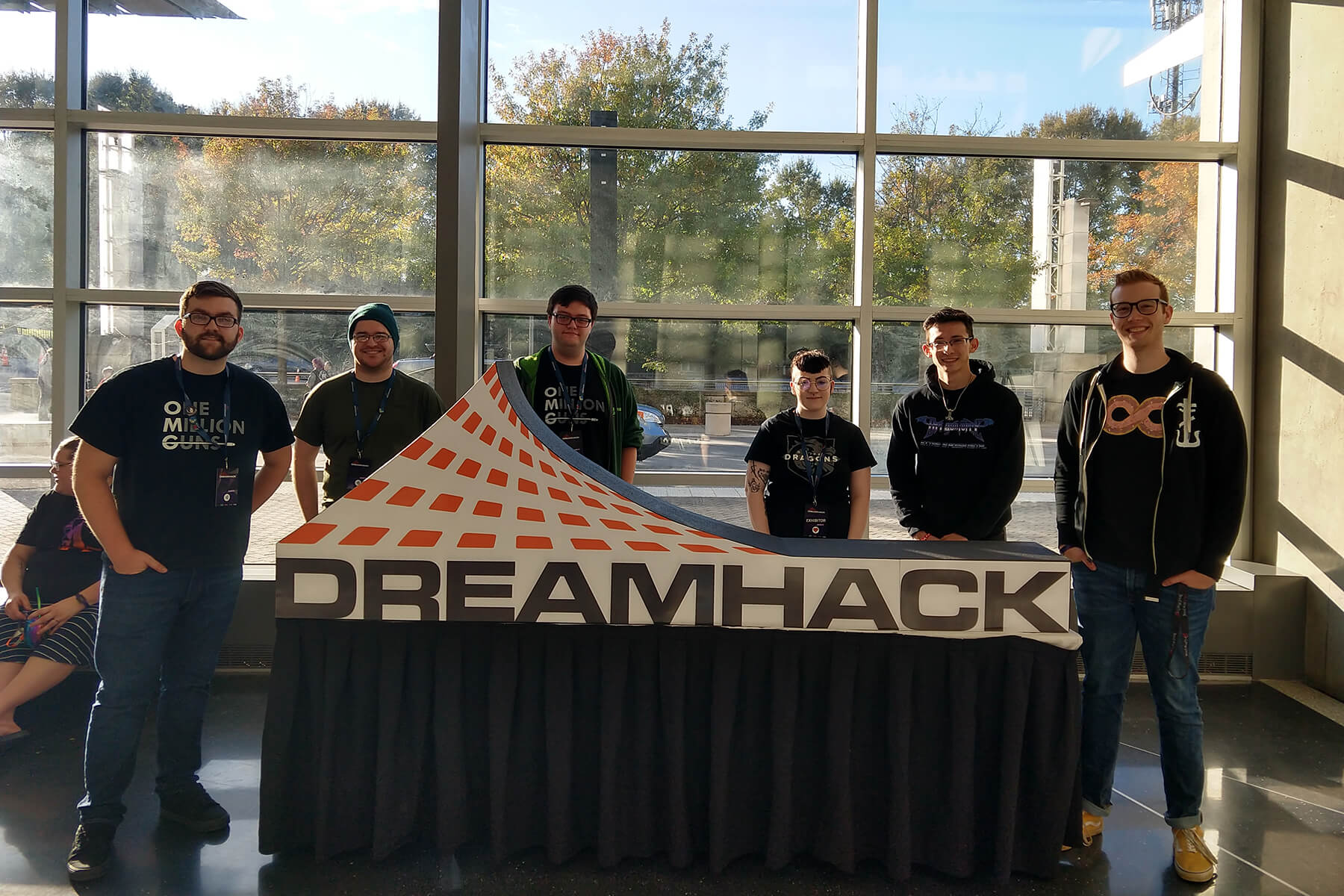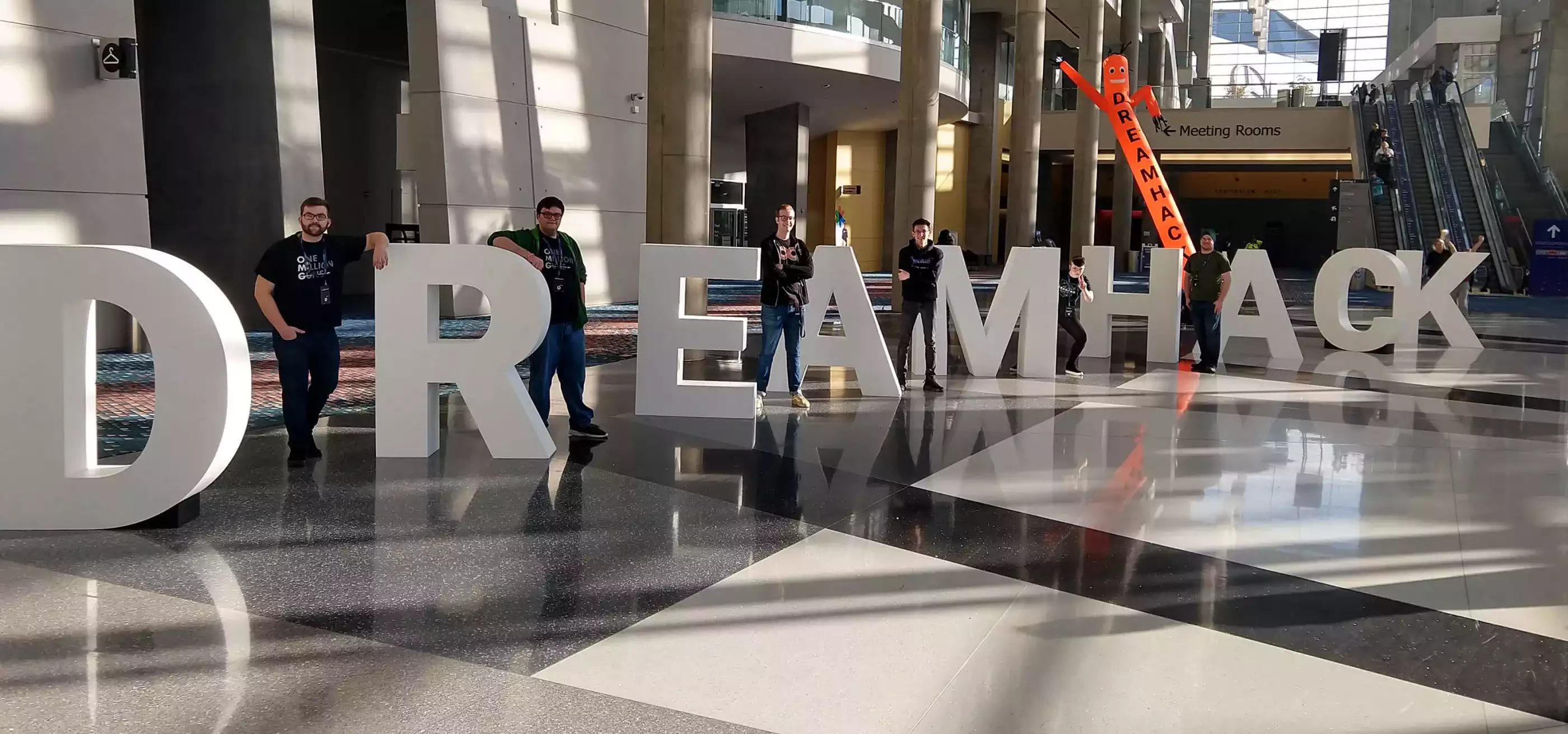It’s one thing to make an awesome game project and share a download link on social media. It’s quite another thing to bring your creation to an audience of gaming enthusiasts, put a physical controller in their hands, and let them try it out on the spot.
A group of six DigiPen students had the opportunity to do the latter this past November by bringing their game projects to DreamHack Atlanta, a three-day festival filled with e-sports tournaments, panels, game exhibits, and more. Three DigiPen student game teams were invited by DreamHack organizers to present their projects as part of the festival’s international Student Game Showcase. I Am Gooey (2019), One Million Guns (2018), and Trouble in Flubville (2018) joined a lineup of 16 student games from schools as far away as Austria.
For the six students who traveled to Atlanta to take part in the event, the experience turned into a valuable networking opportunity as they connected not only with excited gamers, but also with professional indie developers who were there exhibiting as well. Students from each of the three game teams say they received high praise from studio representatives who were impressed with their art, programming, and design chops.
“I brought a set of resumes and some business cards, which people tended to grab over time,” Victoria Ridenour, a senior in the BFA in Digital Art and Animation program and the character animator for the colorful 2D platformer Trouble in Flubville, said. “They took my business cards and said, ‘I’m going to email you.’ Or they asked me, kind of like an impromptu interview, ‘Do you know this software?’ And they asked me about my process.”
One particular area of interest that caught developers’ attentions was the fact that all three DigiPen games on display were created without the use of a commercial game engine, such as Unity or Unreal. They were all running on student-built engines for facilitating graphics, physics, input handling, audio components, and more.

“It blew people’s minds that we built our own engines from scratch. They were like, ‘Wait, you can build an engine?’” David Robson, a junior in the BA in Game Design program who produced and designed for I Am Gooey, said. “I got asked a few times what company I worked for.”
The first official DreamHack was hosted in Sweden in 1997, and the festival holds the Guinness World Record for amassing the largest LAN party ever. This year marked the third annual North American DreamHack Atlanta event, which reportedly drew a record attendance of about 35,000 people who came to spectate, play games, and cosplay.
“The second day I had a constant stream of people coming up and playing our game,” Ridenour said. “I had people wait at least 20 minutes to play.”
“One Million Guns was nice, because it’s 15 minutes, 10 waves of enemies, and it’s over. So we were able to get people in and out pretty quick,” Benjamin Fox, a junior from the BS in Computer Science in Real-Time Interaction Simulation program, said. His freshman-year game project was a top-down shooter that — as the name implies — generates millions of different weapons on the fly. “We actually pulled out the source code, and we calculated the actual number of unique, random guns, because people didn’t believe us. So we were like, ‘You know what? We’ll actually calculate this out,’” Fox said. “It’s actually 1.3 million guns based on different names you can get for the guns.”
For Fox, the showcase afforded a chance to playtest a series of challenge modes that never made it into the final public version of the game.
“We showed off that challenge mode build, and it was very interesting to see how that affected the experience of people playing,” Fox said.
Robson says he also was happy to see the warm reception his team’s game, I Am Gooey, was given.
“It is a 2D angled, top-down puzzle game based on the Japanese Masyu puzzle, but with simplified rulesets to make it easier to play,” Robson said. “I was brutally reminded that I Am Gooey is not exactly convention-friendly, as it is a puzzle game. But once someone started playing it, they didn’t stop, which was really nice.”
Custom engine aside, Robson was also proud to highlight another aspect of his game.
“Indies are also getting in on the accessibility design hype, which was really handy for I Am Gooey, considering the entire game was based around accessibility,” he said. “The entire game can be played even if you have monochromatic vision, and it’s localized for six languages. The indie developers were impressed — and kind of in awe — of that.”
While all of the students are busy working on new game projects and ideas, Robson says it was a real confidence booster to have his work validated by gamers and developers alike.
“It definitely helps with the imposter syndrome,” he said.
“Yeah, for sure,” Ridenour agreed. “Especially when there are a lot of indie studios who are amazed by the work we’ve done. They end up looking up your portfolio then and there, and they’re like, ‘Wow! This is great.’”
The Redmond campus games weren’t the only DigiPen projects selected for DreamHack. The student game Jera from DigiPen Institute of Technology Europe-Bilbao was also invited to demo at the recent DreamHack Winter festival in Jönköping, Sweden, as a part of that festival’s student showcase.
